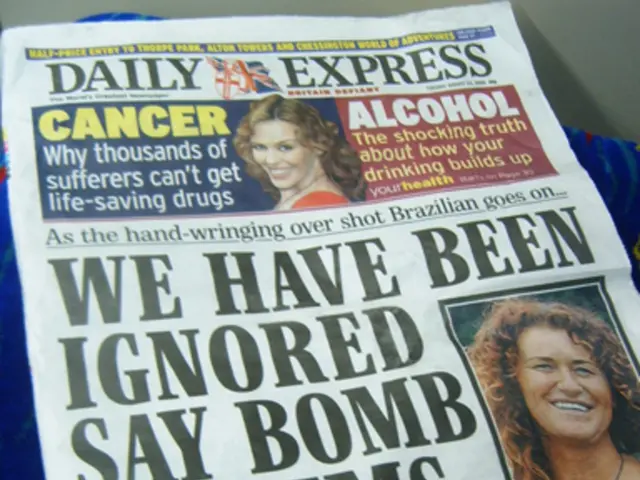Stiffer penalties are necessary to combat the trade of counterfeit pharmaceuticals.
Vietnam Combatants Ramp Up Efforts Against Counterfeit Pharmaceuticals
Ho Chi Minh City - In an effort to combat the proliferation of counterfeit drugs, Vietnam's Thanh Hoa police recently dismantled a significant network responsible for producing and trading fake medications. Despite stringent regulations, the healthcare sector continues to face challenges in stamping out this illicit activity.
The escalating issue poses severe consequences, compromising patient health, eroding public trust in healthcare services, and weakening the pharmaceutical industry. Strict and deterrent penalties are paramount.
At a workshop held in Ho Chi Minh City, Deputy Minister of Health, Dõ Xuân Tuyên, emphasized the critical importance of medicine, stating that it directly impacts human life and health. However, counterfeit and substandard drugs, including traditional medicines, are being peddled rampantly throughout social media, and the problem has become increasingly intricate.
Offenders use trust, gullibility, and even celebrities and doctors' names to promote these counterfeit drugs as "miracle cures." The Deputy Minister of Health strongly condemned and called for the punishment of any individual involved in their production, trading, or distribution, whether it entails only a single pill.
The Ministry of Health has vowed a resolute fight against counterfeit drugs, with no exceptions or "forbidden zones." Simultaneously, authorities plan to address aiding and abetting, managerial irresponsibility, and other factors contributing to the existence of counterfeit drugs in the drug distribution system.
In 2023, Vietnam identified and took administrative and criminal actions against over 160 cases related to the production and trafficking of counterfeit drugs. Meanwhile, in 2024, 27 types of drugs were suspended due to failing to meet quality standards, with eight identified as counterfeit.
Counterfeit drugs today are not just pill copies with forged packaging; they've evolved into sophisticated products, employing modern printing technology, fake QR codes, and forged labels, making them challenging to distinguish from genuine medications, even for industry insiders. In addition, the current post-market surveillance system remains fragmented, and inspection capacity at many facilities is still wanting.
Legal loopholes remain a reason why controlling the circulation of counterfeit drugs remains challenging. Although penalties for the production and trafficking of counterfeit drugs are mentioned in Article 194 of the Penal Code, practical enforcement still faces difficulties. Counterfeit drug production and trafficking rings operate in organized, large-scale, and sophisticated manners, making them challenging to trace and apprehend.
Detailed Tricks and Severe Consequences
The Head of HCM City's Market Management Sub-Department, Nguyễn Quang Huy, revealed that in 2024 alone and the first five months of 2025, his officials detected and processed numerous cases involving pharmaceuticals, cosmetics, functional foods, medicinal herbs, and traditional medicine ingredients. Common violations included trading smuggled goods, goods of unknown origin and source, incorrect price listing, and trading counterfeit branded goods.
Investigations have shown that common methods employed by offenders involve using imported labels to legitimize drugs of unknown origin, source, and quality information. A particularly dangerous tactic is the mixing of genuine drugs with counterfeit ones before they reach the market. This method aims to deceive authorities during inspections and build initial trust with consumers.
Doctor and pharmacist Nguyễn Quốc Bình believes that counterfeit and substandard drugs can lack sufficient dosage, preventing users from achieving therapeutic concentrations. Research reveals that the three most significant dangers of using counterfeit and substandard drugs are the loss of the "golden time" (critical window) for treating the illness, the possibility of introducing foreign or harmful substances into the body, and increased drug interactions, causing the body's detoxification organs to work harder and increasing treatment costs.
Thanh Hóa Police have dismantled a large-scale network involved in the production and trade of counterfeit pharmaceuticals. VNA/VNS Photo
Dr Tạ Mạnh Hùng, Deputy Director of the Drug Administration under the Ministry of Health, highlighted that counterfeit drug producers and sellers have become increasingly sophisticated. They can manufacture goods illicitly without fixed factories, break down the production process into smaller parts, and use social media as a sales channel. Meanwhile, some retail pharmacies do not strictly adhere to regulations, selling drugs without invoices and with untraceable origins, allowing counterfeit products to infiltrate the legitimate system.
Hùng proposed increasing penalties, adding regulations to control online drug sales, publicly disclosing information about distributors, and implementing origin traceability using QR codes. He also advocated for tightening inspections and audits of pharmaceutical businesses, with swift sanctions for violations, particularly those involving sales on social media.
The fight against counterfeit drugs is a complex and prolonged challenge, requiring the involvement of the entire political system and the vigilance and cooperation of the public.
- The Vietnam's Ministry of Health has emphasized the need for stringent regulations in the pharmaceutical industry, considering medicine as crucial to human life and health, given the rampant issue of counterfeit drugs.
- Legal loopholes continue to pose challenges in controlling the circulation of counterfeit drugs, despite penalties mentioned in the Penal Code for their production and trafficking.
- In response to the growing threat, the government is planning to address aiding and abetting, managerial irresponsibility, and fragmented post-market surveillance systems contributing to the existence of counterfeit drugs.
- Offenders use various tactics, such as employing modern printing technology, fake QR codes, and forged labels to make counterfeit drugs challenging to distinguish from genuine medications, even for industry insiders.
- Counterfeit drugs can lead to severe consequences, including compromising patient health, eroding public trust in healthcare services, and weakening the pharmaceutical industry.
- In the realm of health and wellness, general news, crime and justice, science, technology, and AI, it is imperative to address the issue of counterfeit drugs and ensure the quality, safety, and efficacy of all medications.







